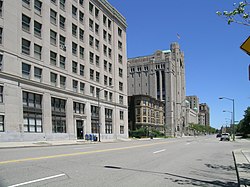Cass Park Historic District
|
Cass Park Historic District
|
|

Temple Street north of Cass Park. The Detroit Masonic Temple is in the midground
|
|
| Location | Temple, Ledyard, and 2nd Sts, Detroit, Michigan |
|---|---|
| Coordinates | 42°20′25″N 83°3′35″W / 42.34028°N 83.05972°WCoordinates: 42°20′25″N 83°3′35″W / 42.34028°N 83.05972°W |
| Architect | Ellington & Weston; et al. |
| Architectural style | Classical Revival, Art Deco |
| NRHP Reference # | 04001580 |
| Added to NRHP | February 2, 2005 |
The Cass Park Historic District is a historic district in Midtown Detroit, Michigan, consisting of 25 buildings along the streets of Temple, Ledyard, and 2nd, surrounding Cass Park. It was listed on the National Register of Historic Places in 2005 and designated a city of Detroit historic district in 2016.
The area surrounding Cass Park was originally laid out as part of a French ribbon farm extending from the Detroit River. Lewis Cass, the park's namesake, purchased the farm in 1816 when he moved to the area. He constructed a house on Larned Street between First and Second Avenues, and in 1840 a larger house on the northwest corner of Fort and Cass Streets. Starting in 1836, Cass began subdividing his land, platting lots between Larned and the river. Over the next 30 years, Cass platted more northerly sections of his claim. The area that now encompasses the Cass Park Historic District began to be sold as lots after 1859. In 1860, Cass deeded a section of land to the city of Detroit, bounded by Second, Ledyard, Cass and Bagg (now Temple), to be used as a public park.
In 1863, the The Detroit City Railway Company began streetcar service Along Woodward Avenue, only a few blocks away from Cass Park. The streetcar cervice spurred development northward along Woodward, including the Cass Park area. The area soon became a fashionable suburb of the city. In 1875, the city landscaped Cass Park, planting a number of new trees. By the 1880s, some of Detroit's most prominent citizens lived along the park, including James Vernor, E. W. Voigt, and John H. Avery. Avery's house at 457 Ledyard is the only residence remaining from this period within the district.
The Cass Park area continued to be a fashionable address into the 1900s. However, the 1890s saw the introduction of upscale apartment buildings. In 1895, the Alhambra Flats at 100-112 Temple was constructed, followed in 1905 by the Cromwell Flats at 2942 Second, and in 1908 by the Ansonia Flats at 2909 Second. As Detrtoit continued developing, apartment buildings with smaller but more numerous units began to appear, including the Manhattan Apartments at 2966 Second in 1905, and the Altadena Apartments at 2952 Second in 1911. This marked a transformation of the Cass Park area, as the single family homes surrounding the park were replaced with apartment buildings to house the city's expanding population. By 1925, a number of new apartment buildings had been constructed.
...
Wikipedia
